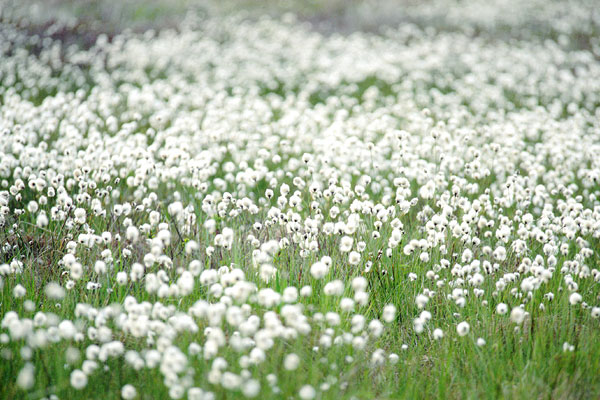Our Wetlands: Ramsar Sites in Kushiro Area
Our Wetlands: Ramsar Sites in Kushiro Area
Kushiro-shitsugen (Kushiro Wetland)
Located in Kushiro City, Kushiro Town, Shibecha Town and Tsurui Village
Registered on the Ramsar List in 1980 (7,863ha)
Kushiro-shitsugen is Japan’s largest wetland, extending 36 km from north to south and 25 km from east to west with a total area of 22,070 ha . It was Japan’s first wetland to be listed under the Ramsar Convention, and consists mostly of reed-sedge marshland with a web of tributaries flowing into the Kushiro River, which runs over the wetland from south to north. Kushiro-shitsugen is a rich habitat for a variety of precious flora and fauna, including the Red-crowned crane (designated as a Special Natural Monument of Japan) and the Siberian salamander (a northern-region relic species found only in certain parts of Japan).
Wetland Conservation
Since its designation as a national park in 1987, Kushiro-shitsugen has been a tourist draw for domestic and international visitors. Its central part, whose natural environment remains pristine, is under stringent protection as a Ramsar site, a Natural Monument of Japan, a National Wildlife Protection Area and a National Park Special Protection Zone.
Despite related conservation efforts, recent land development projects and past river improvement work in surrounding areas have caused wetland vegetation changes and environmental deterioration. To address these problems, nature restoration projects such as work to plant trees in surrounding woodlands and to restore the meander of the Kushiro River have been implemented. The Kushiro Wetland Restoration Committee, which works to re-establish the natural environment of Kushiro-shitsugen, has a membership of more than 100 individuals and organizations. These include administrative agencies, local NGOs engaging in conservation activities, researchers and schools providing environmental education.
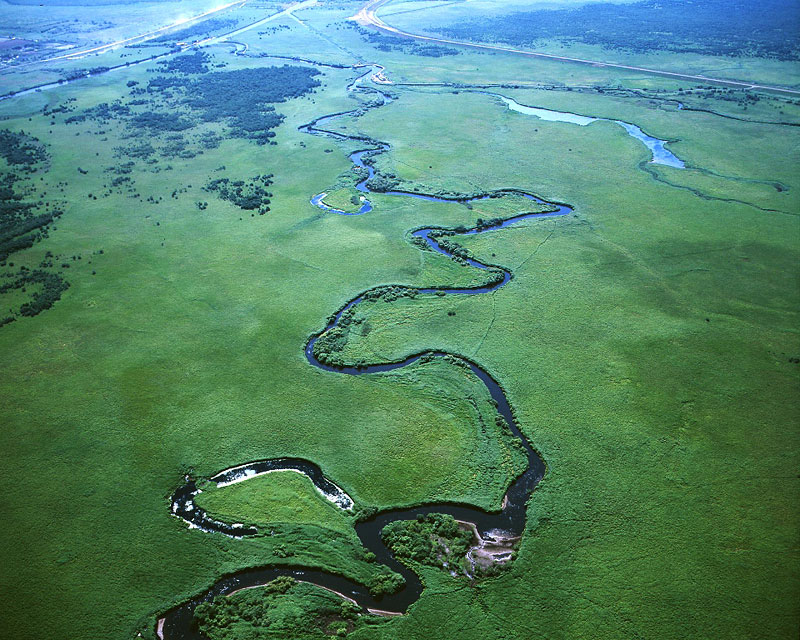
Wetland Enjoyment
Extensive Wetland Landscapes
An observatory located on high ground near the wetland commands panoramic views of the area and its web of streams. Visitors can stroll on boardwalks over the wetland and canoe along its rivers to enjoy the local natural characteristics up close. Tours with a variety of objectives for all fitness levels are organized, with particular guided sessions providing even greater levels of discovery and excitement.
Visitors to the region can also make use of local facilities and programs to enjoy wetland activities all year round, including camping, horseback riding and cross-country skiing.
Encounter with the Red-crowned Crane: a Swamp-dwelling Deity
The Red-crowned crane is well known in Japan for its appearance in folk stories and its depiction in Japanese garment designs and artistic crafts. Kushiro-shitsugen is a habitat for the species, which is called Sarorun Kamuy (swamp-dwelling deity) in the Ainu language. The population of these cranes previously dwindled so much as a result of overdevelopment and excessive hunting that it was considered to no longer exist in Japan. However, since a small surviving flock was discovered in Kushiro-shitsugen in 1924, local residents and others have worked to carefully protect the species.
Today, winter feeding grounds created for red-crowned cranes at several locations near the wetland are busy with cranes, bird watchers and photographers. As a habitat for 170 bird species including these cranes, Kushiro-shitsugen is the ideal destination for bird watching.
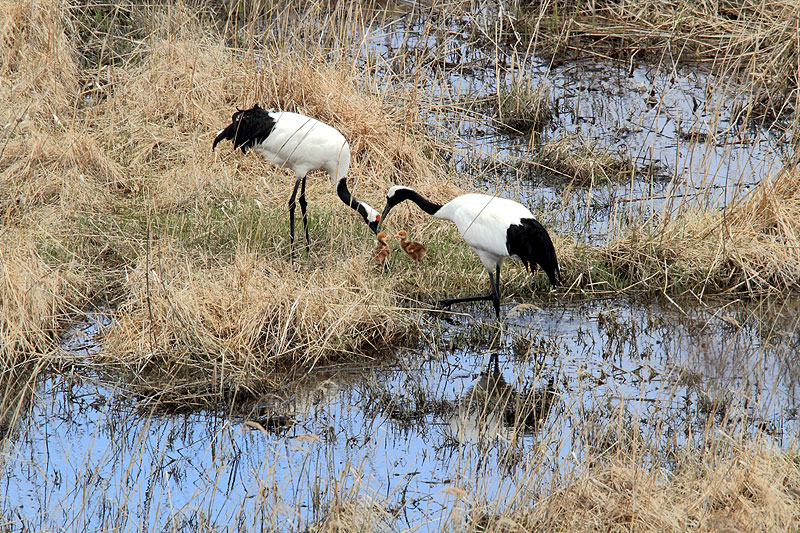
Akan-ko (Lake Akan)
Located in Kushiro City
Registered on the Ramsar List in 2005 (1,318ha)
Akan-ko is a crater lake (circumference: 25.9 km) located between two active volcanoes called Mt. Oakan and Mt. Meakan. It is home to the Japanese huchen (one of Japan’s largest freshwater fish) and a variety of rare aquatic plants and animals. These include the area’s renowned marimo algae balls, which are designated as a Special Natural Monument of Japan. Lake Akan is the only place in the world where such large marimo balls are found.
The lake is surrounded by dense forest land providing habitats for Brown bears, Sika deer and other large mammals as well as rare birds such as Black woodpeckers and Blakiston’s fish owls, which are designated as Natural Monuments of Japan.
Conservation of Lakes and Forests
Akan National Park, which encompasses Lake Akan and other lakes and volcanoes, was established in 1934 and is one of the two oldest national parks in Hokkaido. Registered under the Ramsar Convention, Lake Akan has long been a popular tourist destination for its magnificent natural heritage and hot springs.
Near Lake Akan are mountain forests where logging was active for a century when the land was owned privately. The Maeda Ippoen Foundation has since taken over ownership of the forests, and manages them to conserve their rich natural environment. Public access to these forests is restricted.
Both the public and private sectors have engaged in various activities to protect marimo algae balls and their habitat, including surveys by local nature conservation organizations and education/public awareness activities in collaboration with schools.
Enjoyment of the Lake and Forests
Experience of Ainu Culture with Focus on Harmonious Coexistence with Nature
The Lake Akan area has long been inhabited by indigenous Japanese Ainu communities, and the area’s hot spring resort has a private museum and a theater showcasing Ainu culture. The theater puts on traditional Ainu dance displays, puppet plays and other performances featuring the ecology of wild animals and Ainu myths. Traditional Ainu dance is designated as an Important Intangible Folk Cultural Property of Japan. The area also provides various programs, including hands-on sessions for traditional woodcarving and musical instrument making, and forest walking tours intended to highlight the wisdom of the Ainu people who live in harmony with the natural environment of this cold northern region.
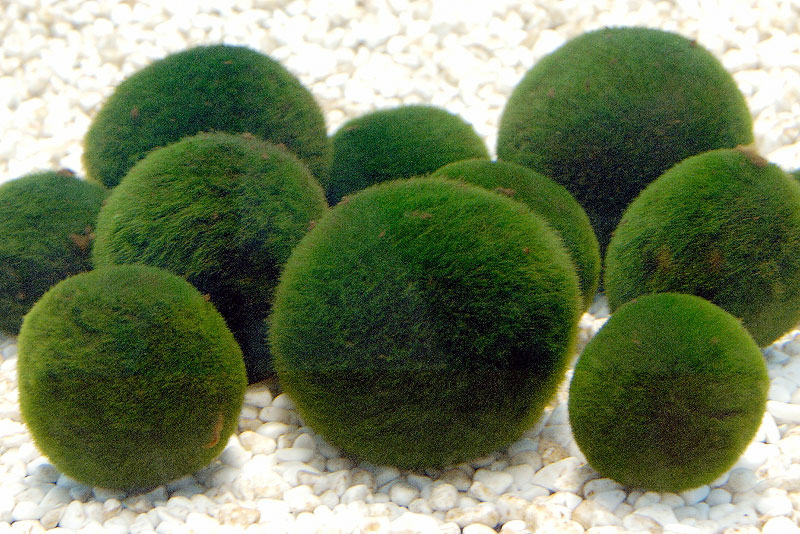
Visits to Natural Wildlife Habitats
In the Lake Akan area, forest nature trails and hiking routes to volcanoes provide visitors with opportunities to enjoy the stunning local scenery. Guided tours also take place in private forests along limited routes and only in certain seasons in consideration of the environment. Mountain climbing, camping, fishing and other outdoor leisure activities are other great ways to explore the area.
With its location in a national park, the Lake Akan area provides habitats for rare animals and plants including Blakiston’s fish owls, Black woodpeckers and marimo algae balls. As the area is also inhabited by Brown bears, visitors are asked to follow proper etiquette and rules when engaging in outdoor activities. To protect fish resources, limitations are placed on the period when fishing is allowed in Lake Akan and parts of the upper reaches of the Akan River. Restrictions are also placed on the types and numbers of fish that can be caught.
Enjoyment of the Local Cold Winter Conditions
In the cold winter of the Lake Akan area, temperatures often fall below -20°C. This provides opportunities for a variety of winter activities, including pond smelt fishing on the lake’s thick ice, snow-shoe trekking and cross-country skiing. Local hot spring facilities are a great place to warm up after a day enjoying the natural beauty of winter.
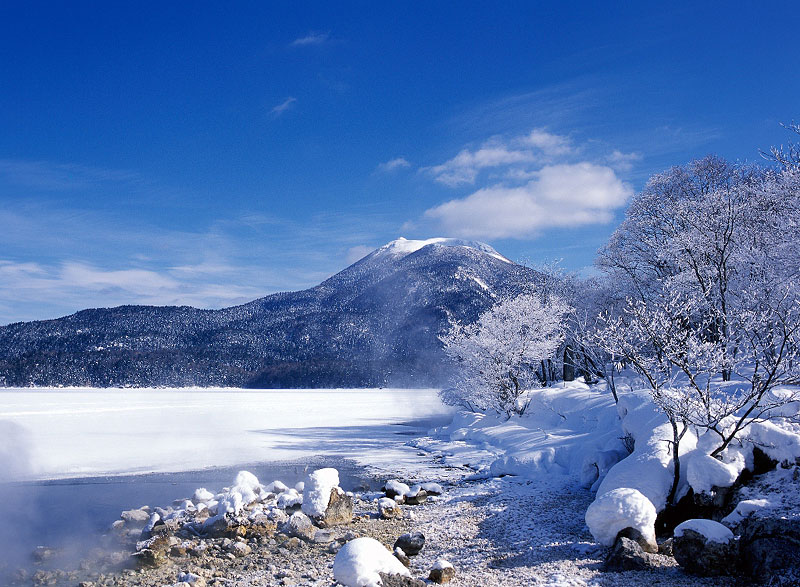
Akkeshi-ko and Bekambeushi-shitsugen (Lake Akkeshi and Bekambeushi Wetland)
Located in Akkeshi Town
Registered on the Ramsar List in 1993 (5,277ha)
Akkeshi-ko is a brackish-water lake connecting to the Pacific. It is a key stopover and wintering site for waterfowl in Japan, hosting more than 10,000 Whooper swans every winter.
Bekambeushi-shitsugen stretches along the Bekambeushi River (which flows into Lake Akkeshi) and its tributaries. Its total area of around 8,300 ha is largely composed of extensive reed and sedge fens. Most of the wetland remains pristine and untouched. It is home to a number of rare forms of wildlife, including Red-crowned cranes and Japanese huchen.
Conservation of the Lake and the Wetland
The area encompassing Akkeshi-ko and Bekambeushi-shitsugen is designated a National Wildlife Protection Area, and the special protection zone encompassing Akkeshi Bay is registered under the Ramsar Convention. The lower reaches of the Bekambeushi River and the coastal area stretching from Lake Akkeshi to Kiritappu-shitsugen in Hamanaka Town are designated as part of Akkeshi Prefectural Natural Park.
Lake Akkeshi serves as an important base for the town’s key fishing industry, and is known for aquaculture of oysters and Short-neck clams, under-ice net fishing on the lake ice in winter, and other activities. Locals plant trees in the upper reaches of the Bekambeushi River, use environmentally friendly soap and engage in various other activities to protect the marine environment and local fishing grounds with the aim of conserving both the river that flows into the sea and the forests at its head. In addition to actively supporting these activities, Akkeshi Town Office conducts surveys and research with a base in the Akkeshi Waterfowl Observation Center and provides assistance to researchers through a subsidy program.
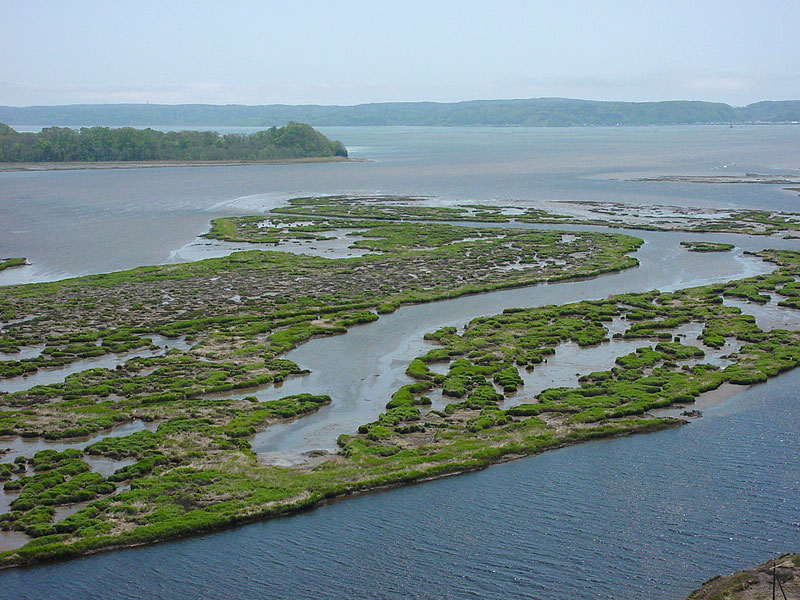
Enjoyment of the Lake and the Wetland
Natural Landscape Surroundings
Local business operators organize canoe tours using canoe ports in the middle and lower reaches of the Bekambeushi River. A leisurely paddle along the river in wholly natural wetland surroundings may provide visitors with opportunities to spot Sika deer, Red-crowned cranes or even Brown bears.
To protect these wild animals, the locations and opening periods of canoe stations along the Bekambeushi River as well as the maximum number of canoes that can be operated each day are limited. A presentation on nature and wildlife protection is provided for visitors canoeing along the river for the first time.
Observation of Birds Surviving the Cold Winter
In autumn, whooper swans and ducks come to Lake Akkeshi from northern regions. Most water birds head far south when ice covers the lake in winter, leaving it open for Steller’s sea eagles, White-tailed eagles and other large birds of prey attracted by scraps from under-ice net fishing. Live footage from the lake taken using remote cameras is shown on a large screen at the Akkeshi Waterfowl Observation Center along the Bekambeushi River.
Enjoyment of Gifts from the Lake
Oysters and short-neck clams grown in Lake Akkeshi are used in various Japanese, Western, Chinese and other dishes at local restaurants. Clam digging trips to the sandy shores of Lake Akkeshi are a popular family activity.
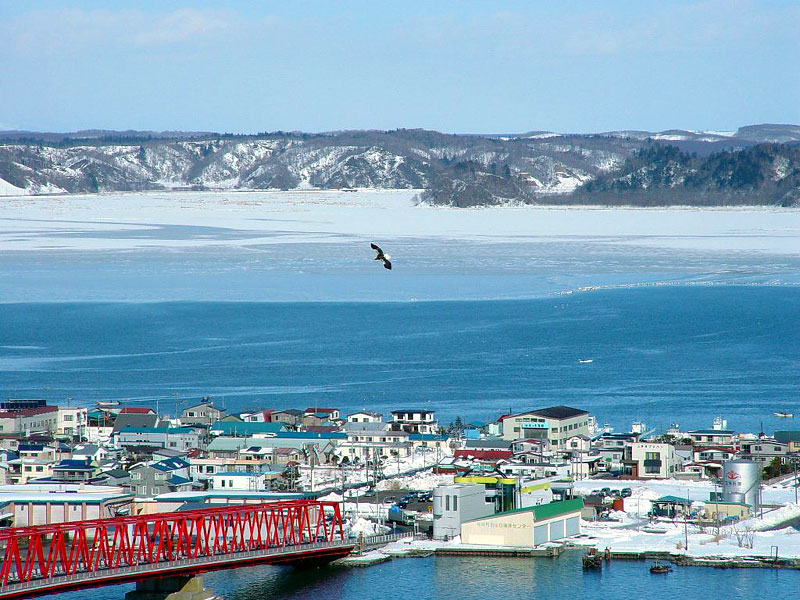
Kiritappu-shitsugen (Kiritappu Wetland)
Located in Hamanaka Town
Registered on the Ramsar List in 1993 (2,504ha)
Facing the Pacific Ocean, Kiritappu-shitsugen extends 9kmfrom north to south and 3 to 4km from east to west. It is a bog mainly composed of sphagnum peat with five rivers and more than thirty ponds. At high tide, seawater flows along the rivers into the central part of the wetland. It is particularly popular with tourists in summer for its variety of flowers.
Wetland Conservation
The central area of Kiritappu-shitsugen is designated as a Natural Monument of Japan for its peat bog plant communities. The Ramsar site covers the main area of the marshland and two brackish water lakes (Lake Hichirippu and Lake Mochirippu) in the west. It is also a National Wildlife Protection Area Special Protection Zone. The whole area is designated as Akkeshi Prefectural Natural Park, and is a strong tourist draw with its rich natural environment and beautiful scenery.
The Kiritappu Wetland National Trust is an NPO operated by locals. It works in conjunction with the government, local fishermen, farmers and schools to promote the conservation and use of the wetland. The group’s activities include the provision of environmental education programs and the development of local specialties and tours capitalizing on the local key industries of agriculture and fisheries, in addition to national trust campaigns to buy or rent land for the establishment of private protected areas and boardwalk installation work.
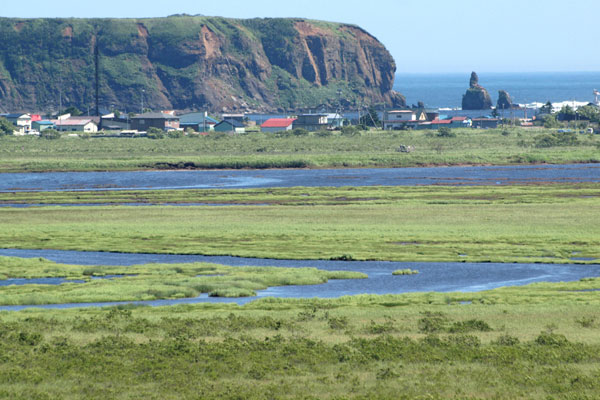
Enjoyment of the Wetland
Natural Flower Garden
On the wetland, Hare’s-tail cottongrass, Day lilies and a variety of other flowers bloom from spring to autumn. Four boardwalks over the terrain provide opportunities for visitors to enjoy a leisurely stroll among the flowers and hear the songs of birds. Guided tours are also operated, offering chances for people of all interests and ages to learn about Kiritappu-shitsugen’s seasonal charms, including the mechanism behind its natural cycle, flowers, birds and insects. Visitors may even be lucky enough to spot Red-crowned cranes and Sika deer.
Support for Kiritappu-shitsugen
The boardwalks on the wetland were installed by local residents and other volunteers, who maintain and repair them every year. The repair work itself is a popular event, and attracts many people from the town and elsewhere. Kiritappu-shitsugen has the air of a special place that these people want to visit repeatedly to work with locals and cultivate friendships.
